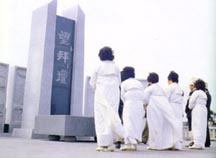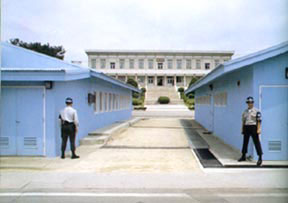![]()
|
|
|
|
|
|
|
|
|
|
|
|
DMZ Tours
By Yvonne Kennedy
In the lobby of every international hotel in Seoul, beside the concierge desk, visitors will find a rack of brochures for package tours to places of interest in Korea, including a daily tour to the Demilitarized Zone (DMZ), the frontline of the ongoing Korean Cold War.
 |
| South Koreans with family in the North conduct ancestral rites at this shrine near the DMZ, looking toward the north. |
The tour, organized by the United Service Organization (USO) in Seoul, costs about US$30, and includes a 60-minute roundtrip bus ride north to the village of Panmunjom on the 38th Parallel.
"War as tourism" is a disturbing concept. Disturbing, too, is that South Korean civilians are not allowed to see this popular tourist attraction in their own country.
 |
| Soldiers on the South Korean side stand guard between two of the Military Armistice Commission meeting rooms that straddle North and South Korea. |
The tour departs daily from the USO Office, near the Yongsan Army Base in downtown Seoul. At least 40,000 U.S. troops are currently stationed in Korea, most of them in Yongsan, some further south in Pusan, a few at Camp Bonifas in Panmunjom.
Around 40 tourists a day, most of them from Western nations, climb onto the tour bus with an English-speaking Korean tour guide aboard. She points out landmarks of interest on Unification Road, the main thoroughfare connecting Seoul and Panmunjom. Passengers note an austere stone archway called Independence Gate and then the Mangbaedan, a 20-foot marble pillar engraved with three Chinese characters that mean "Worshiping-from-Afar Altar," where South Koreans with family members in North Korea lay out offerings and pray on special holidays.
For almost half a century since the outbreak of the Korean War in 1950, hundreds of thousands of Korean families have been separated with no possibility of contact. After a historic summit between the two heads of government this year, one hundred people on each side have been allowed to travel across the border for brief, emotional reunions with long lost family members.
The New York Times reports that 100,000 South Koreans are on waiting lists for this family-visit program, most of them elderly.
Currently, the northernmost point for South Koreans to travel without special permission is the shore of the Imjin River. When the bus reaches this point in the tour, an American soldier in military fatigues steps on the bus to replace the Korean tour guide.
The soldier-guide points out special landmarks, like the Bridge of No Return that spans the Sachon River. This is where all prisoners of war were repatriated after the end of the Korea War. The bridge is the only ground link between Seoul and Pyongyang.
The American guide also points out the "Most Dangerous Golf Course in the World," a one-hole course surrounded on three sides by mine fields. A sign warns golfers not to attempt to pick up stray balls.
In the tense truce maintained at the DMZ, the war is a psychological one.
On top of a hill at "Check Point Number 3," visitors file out of the bus for a panoramic view. The North Korean "Propaganda Village" lies on one side. the facade of a happy farm village with no inhabitants but a handful of "caretakers."
Mirroring Propaganda Village is the "Freedom Village" where South Koreans with ancestral ties to the area receive government subsidies to farm huge tracks of land, around 14 to 17 acres. They are also subjected to 6 to 12 hours of daily North Korean propaganda broadcast from loudspeakers at the border.
Perhaps the DMZ tour is less "war as tourism," and more "tourism as war." The daily busload of vacationing tourists, who snap pictures at their leisure and talk easily with their soldier tour guides, is a tacit taunt.
Sometimes the taunt grows overt. Each group of tourists is brought into one of the long Military Armistice Commission meeting rooms that straddle the border. Representatives from the two sides meet here for regular talks, and visitors can "cross over" to the North Korean side where North Korean soldiers stand guard outside the windows and glare unflinchingly into the room. Tourists are encouraged to have their photos taken by these windows, with North Korean soldiers as backdrop.
The tour may have a lighthearted feel, but tourists are warned that war could break out at any moment. They are asked to sign a Visitor's Declaration that frees the military of responsibility for their safety in case of a conflict, and to refrain from making gestures or faces which "could be used by the North Korean side as propaganda material."
And pointing is not allowed because, the guide claims, from a distance an outstretched arm with an extended finger could appear to be a weapon taking aim, causing the other side to open fire.
Tensions are volatile at the DMZ. Since the border was closed between North and South Korea with the signing of the Armistice Agreement in 1953, Koreans on both sides have attempted to defect across the DMZ that separates them. In the tensely guarded crossing at Panmunjom, a defection could quickly lead to open fire - one side trying to protect the defector and the other side attempting a capture.
Last week, when reunion organizers at the South Korean Red Cross proposed Panmunjom as a venue for the next family reunion, their North Korean counterparts refused and suggested a mountain retreat in North Korea instead. Selecting a meeting place has political implications because both sides are aware of the defection risk in a long awaited reunion.
Although tenstions have eased, the psychological war has not ended, and South Korean nationals are still not allowed to visit Panmunjom. But for US$30, international tourists can take this unsettling tour and snap their cameras with flippant disregard for the role they play in the division between the two Koreas.